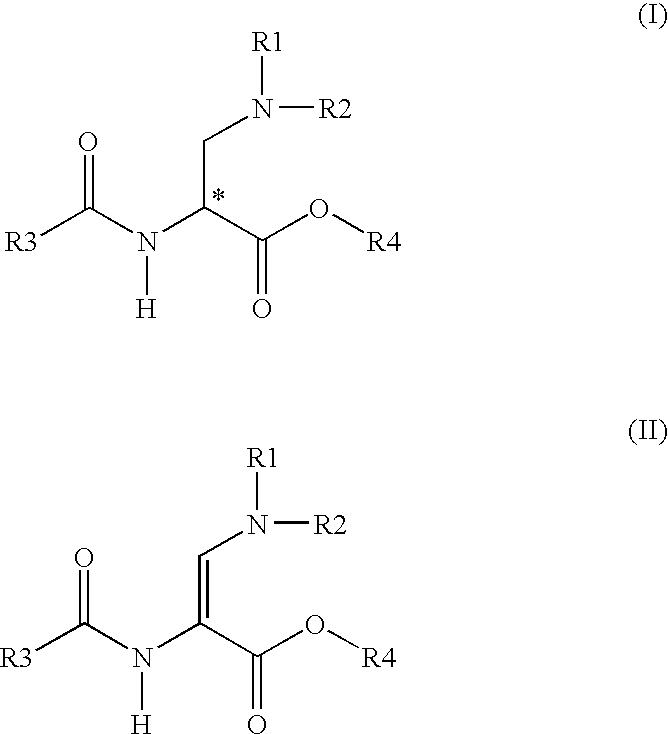Method for producing enantiomeric form of 2,3-diaminopropionic acid derivatives
a technology of diaminopropionic acid and enantiomeric form, which is applied in the preparation of carbamic acid derivatives, amino-carboxyl compound preparations, organic chemistry, etc., can solve problems such as asymmetric hydrogenation success
- Summary
- Abstract
- Description
- Claims
- Application Information
AI Technical Summary
Benefits of technology
Problems solved by technology
Method used
Image
Examples
example 1
Preparation of methyl 2-benzoylamino-3-diphenylaminoacrylate
[0112]
[0113]66 g (266 mmol) of methyl 2-benzoylamino-3-dimethylaminoacrylate and 50 g (295 mmol) of diphenylamine were dissolved at 40° C. in 1300 ml of isopropanol. The solution was admixed with 60 ml (725 mmol) of concentrated hydrochloric acid within 5 minutes (min) and stirred for a further 10 min. 550 ml of solvent were evaporated off under reduced pressure, the suspension was cooled to 10° C. and the crystallized product was filtered off.
Yield: 83.5 g (84% of theory)
1H NMR: 3.62 (s, 3H), 6.95-7.10 (m, 6H), 7.20-7.30 (m, 8H), 7.32-7.40 (m, 1H), 7.61 (s, 1H), 8.70 (s, 1H)
example 2
Preparation of methyl 2-benzyloxycarbonylamino-3-diphenylaminoacrylate
[0114]
[0115]36 g (129 mmol) of methyl 2-benzyloxycarbonylamino-3-dimethylaminoacrylate and 24.12 g (142 mmol) of diphenylamine were dissolved in 630 ml of isopropanol at 40° C. Subsequently, the solution was admixed with 17.4 ml of concentrated hydrochloric acid within 5 min and stirred at 40° C. for a further 30 min. The reaction solution was concentrated to 300 ml and admixed slowly with 300 ml of water. The crystallized product was filtered off with suction and dried at 40° C. under reduced pressure.
Yield: 30.5 g (59% of theory)
1H NMR: 3.62 (s, 3H), 4.68 (s, 2H), 6.95-7.10 (m, 6H), 7.20-7.50 (m, 9H), 7.61 (s, 1H)
example 3
Preparation of racemic methyl 2-benzoylamino-3-diphenylaminopropionate
[0116]
[0117]With exclusion of oxygen, an autoclave was charged with 1 g (2.68 mmol) of methyl 2-benzoylamino-3-diphenylaminoacrylate and 40 mg (0.042 mmol) of tris(triphenylphosphine)rhodium(1) chloride. After purging with argon, 40 ml of oxygen-free methanol were added. The autoclave was sealed gas-tight and the solution was hydrogenated at RT for 20 hours (h). The autoclave was decompressed and purged with nitrogen. The solvent was evaporated off under reduced pressure and the residue was chromatographed through a column filled with silica gel 60 (eluent: 1:1 ethyl acetate / heptane). After the solvents had been evaporated off under reduced pressure, a white solid remained, which was utilized for the formulation of a method and as a system test for the determination of the enantiomeric purity by HPLC on chiral phase.[0118]HPLC column: Chiralpak OD 4×250[0119]Eluent: 45:2:1 hexane / EtOH / MeOH+0.1% diethylamine[0120]T...
PUM
 Login to View More
Login to View More Abstract
Description
Claims
Application Information
 Login to View More
Login to View More - R&D
- Intellectual Property
- Life Sciences
- Materials
- Tech Scout
- Unparalleled Data Quality
- Higher Quality Content
- 60% Fewer Hallucinations
Browse by: Latest US Patents, China's latest patents, Technical Efficacy Thesaurus, Application Domain, Technology Topic, Popular Technical Reports.
© 2025 PatSnap. All rights reserved.Legal|Privacy policy|Modern Slavery Act Transparency Statement|Sitemap|About US| Contact US: help@patsnap.com



